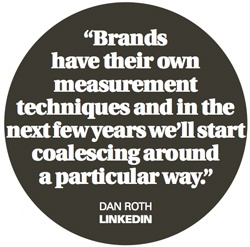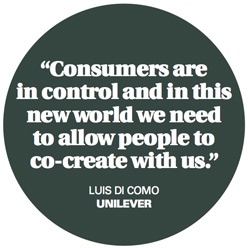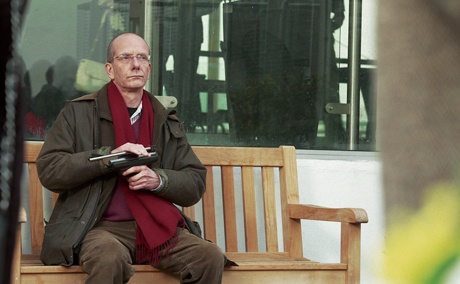Live in the moment
Brands need to make their marketing topical and reactive - known as ‘moment marketing’ - in today’s digital world where consumers are calling the shots.
In a technique that brings together content, the ‘always on’ consumer and personalisation, brands are looking at how they can use ‘moment marketing’ to react to current events and engage with individuals.
“There isn’t just one consumer, there are millions with individual needs and preferences. Personalisation is going to be extremely important in everything we do,” said Tesco.com international director Frans Falize at this year’s Festival of Media Global.
Falize says that the future will involve targeting people individually with promotions that are relevant to what they are likely to buy “and that enhance the chance of [each shopper] actually purchasing something”.
This means allowing consumers to be part of the conversation and reacting with relevant and topical content that does more than tell people to buy certain products. Known as ‘moment marketing’, it is a technique being picked up by companies including Unilever, Nestlé, Nando’s and Visa. Whether it is communicating with each customer in real time or responding to events as they happen, savvy brands are putting themselves at the heart of current events.
Unilever senior vice-president of global media Luis Di Como says that the days of the big traditional ad campaign are numbered.

Talking at the same event in Switzerland, he said: “The digital revolution has transformed everything we do. We have moved from the world wide web (www)to this new concept of what we want, when we want, where we want (www.www.www). This is the new paradigm for us. Consumers are at the centre of it and are in control of it.”
To illustrate this shift in consumer behaviour he highlighted a picture of the crowd in Rome’s St Peter’s Square ahead of the new Pope being announced in 2005 compared with when the latest Pope was announced this year. In 2005, one or two mobile phones can be seen but in 2013 the crowd is a sea of white light as most people can be seen taking pictures on their mobile device.
“It demonstrates a shift in consumer behaviour, in the way people consume, create and share content all over the world,” he said. “Consumers are in control, and in this new world we need to allow people to co-create with us.”
Stewart Dryburgh, global marketing head at Nestlé brand Kit Kat, agrees that brands must step back from big campaigns in isolation because although television is still an important medium, it only works for a window of time.
“Social media platforms like Facebook give us the ability to be there day in and day out,” he says.
“You have to think about it in two ways: what is the big campaign and what is the daily conversation? Confectionery has low loyalty. People have an average of five chocolate brands that they buy, so for us it’s not all about loyalty, it’s about being top of mind and being engaged.”
In order to do that Dryburgh says the brand has a budget for ‘moment marketing’, allowing it to react to topical news or events with relevant activity that is turned around in hours. This fits in with the buying patterns for chocolate bars, which tend to be impulsive.
But, it is “not ambush marketing as some brands do,” he says, it is “about enhancing a moment that is happening”.
When the Red Bull Stratos space jump was postponed last October due to bad weather, Kit Kat took advantage by posting an ad showing a Felix Baumgartner character sitting in a spacesuit, watching TV with the strapline: ‘It could be a long wait Felix… Have a break, have a Kit Kat’.
“It’s got a nice engagement,” says Dryburgh, “the agency [JWT] came to us the following morning with an idea to put a Kit Kat in a weather balloon and send it to space.”
Activity must be consistent with the overall brand message though, insists Dryburgh, who says the link with Kit Kat on this occasion was “a break from gravity”.
Within 24 hours of the idea being suggested a Kit Kat had been attached to a balloon, sent to space, filmed, edited and the video was on Facebook.
“The challenge that sets out for brand owners is the ability to respond very quickly in terms of being able to convert an idea. If Felix had jumped on the Tuesday, there wouldn’t have been a story for us. He was delayed and we were ready and able to react and do something with it.”
More recently, Kit Kat took inspiration from Manchester United manager Sir Alex Ferguson’s retirement as a marketing opportunity, honing in on his reputation of giving players the ‘hairdryer treatment’ - the up-close and explosive talks he gave footballers in the dressing room.
The confectionary brand posted an ad on Facebook later that day featuring a hairdryer and a melting Kit Kat next to the line ‘with Sir Alex retiring, now Man U can have a break from the hairdryer treatment’.
Nestlé was not the only brand to turn the long-standing manager’s departure into a marketing opportunity. Currys and PC World offered consumers a 20 per cent discount on hairdryers via a Facebook post featuring a picture of Ferguson with two hairdryers.
Nando’s made a play on ‘Fergie time’ - Ferguson’s renowned ability to get extra injury time added. All its restaurants in Manchester stayed open for an extra five minutes on the day of the announcement, which it told people about through its website and other social media sites.
Nando’s is a veteran of marketing that takes advantage of news, making a spoof video of Zimbabwean dictator Robert Mugabe reminiscing about fun times with fallen comrades in 2011. Grant Hunter and Jon Burkhart highlight this in their book ‘Newsjacking: The Urgent Genius of Real-time Advertising’, saying: “Nando’s had shown how to strike gold by relating a topical story to the brand and taking it to a satirical, playful extreme”.

Paddy Power launched its We Hear You campaign ahead of the Cheltenham Festival race meeting in 2012 in response to a Facebook comment on its site
But Hunter, who is also a creative director for Iris Worldwide, points out that using this strategy can backfire.
In an extreme example, a Friends Reunited employee posted a tweet in the aftermath of last week’s Woolwich attack, in which a soldier was killed. The social network, which focuses heavily on nostalgia, posted an image of the area with the caption “Woolwich in quieter days…long before alleged shootings and beheadings of today.”
It was forced to apologise and suspended the employee who sent the image. Hunter says: “Brands should be defining what their social purpose is before they dive in. Catching the wave of a trending story should be done in a genuine and relevant way.”
Some brands have reactive marketing firmly on the agenda and a strategy to carry it out effectively. Mark Singleton, head of sportsbook marketing at Paddy Power, says speed and authenticity are key.
On the day of Ferguson’s retirement, the betting company erected a digital poster outside Liverpool Lime Street Station that said ‘Some Scouser has one wish left’ alongside a genie’s lamp and a list including Maggie and Fergie - both of which were crossed out - and Liverpool to win the league with odds of 25-1. Pictures of the billboard were posted on Facebook and have been shared more than 3,700 times, ‘liked’ almost 6,500 times, and generated hundreds of comments.
Social content has been a key part of Paddy Power’s marketing strategy since last year as it looked to reposition itself as a “participant in culture” rather than a gambling company, he says.
Paddy Power launched the We Hear You campaign ahead of the Cheltenham Festival race meeting in 2012 in response to a comment posted by fan Dan Collins on its Facebook page, which said: “I hope the chavs don’t ruin Cheltenham like they did Ascot”.
The bookmaker created a YouTube ad in which it promised to tranquilise chavs at the event, with the strapline ‘We hear you, Dan Collins’.
It is this personal approach that is “absolutely critical” to Paddy Power’s strategy, says Singleton.
However, unlike Kit Kat, Paddy Power does not set aside a specific budget for this activity because he says it is weaved into its overall approach.

Connecting with consumers in real time with targeted messages is also high on Tesco’s agenda. Falize points out that as stores have Wi-Fi, shoppers will be able to share offers and in-store events with friends via social media.
The idea that consumers have more control is echoed by Visa chief marketing officer of core products Kevin Burke.
“Retailers know that consumers have this new power and access to information, so what we need to do as marketers is look at these data sets, find ways of creating hyper-relevant content, and engaging with consumers along that journey so we can help shape their behaviour.”
During the 2012 Olympics, Visa used people’s social graphs to customise the content that it delivered and optimise the rotation of that content based on what consumers were discussing.
The payment company also provided ‘real-time marketing messages’ to consumers using footage of actual events, and was able to get moments from the Olympics on air in the US within four hours.
It took footage of athletes winning medals and worked with its partners at OMD and TBWA to insert content into a template, adding videos of cheering fans, which had been sent via Facebook.
Burke says: “We need to embrace the shift in power into the hands of consumers. We have to look at the consumer decision journey, the idea that people consider, evaluate, buy and advocate, and find a way to insert ourselves into that journey with content to shake them into advocates.”
Regarding branded content, Dan Roth, executive editor of LinkedIn, says brands need to be happy to relinquish some control and accept that the conversation might not always go as intended.
Measuring return on investment is another common cause for concern, according to Roth, but he says that should not put brands off as it is easier to see the downside of not doing it.
“Should it be measured by click-through rate, comments, or using a virality rate? That’s the question. We’ve seen brands come up with their own [measurement techniques] and I think over the next couple of years we’ll start coalescing around a particular way to measure success.”
Kit Kat’s Dryburgh says it was difficult to see where the value was when it started leveraging social content, but he knew that it “felt right”.
“If you’ve got a couple of million people engaging with you of their own free will, doesn’t that tell you something?” he asks.
“We’ve got hard numbers that show where the value has been added by leveraging Facebook… But that’s the critical thing: it’s part of the mix, it’s not the only thing we’re going to do.”

Paddy Power has used YouTube for its We Hear You campaign

Bob Bakish
President and chief executive
Viacom International Media Networks
Marketing Week (MW): At the Festival of Media Global, you talked about the concept of ‘living media’ — what does that mean for Viacom?
Bob Bakish (BB): Living media is the seamless fusion of linear programming, second and third screen content, viewer and cast interactions and social media engagement.
It came together as we looked at how today’s consumers behave. It’s the confluence of all these things which in turn means it has never been a better time to be a fan of TV because you can immerse yourself in it. Consumers are living with media in real time and it’s a very powerful phenomenon.
MW: How are you embracing the shift in power to consumers?
BB: We talk a lot about technology being a game changer but in a way that is irrelevant. What’s really going on is that the consumer now has more control. That means it is important for us to be able to extend the experience of our franchises. For shows like Geordie Shore it is just as important to connect with consumers between seasons because there isn’t always going to be new episodes. We want to create [and maintain] excitement. We want people to wonder which characters are going to be cast in the show, for example, which is why we created the mystery Twitter handles [ahead of the season].
MW: What is the biggest opportunity for Viacom?
BB: The consumer. Today [content] can be consumed anywhere and that brings different complexities, but it fundamentally means there is more time available to connect with consumers and through these extensions we’ve built there are more opportunities to interact and create value with partners.

Dan Roth
Executive editor
LinkedIn
If I could offer one piece of advice it would be to take risks and try things. You don’t always know what’s going to work and what isn’t, but you need to be able to move fast and innovate. During the Super Bowl blackout, for example, Oreos created a campaign very quickly and had a real-time marketing team in place to take advantage of the situation.
Every brand has to think about empowering their people to be able to move quickly. They need to think about who they trust with their branding and brand image and how to give them the power they need to make intelligent decisions quickly. How do you make sure they feel like they have the power to do that and they aren’t going to get fired if things go wrong? Every once in a while things may blow up. That’s something that brands need to consider.
It’s also important to be authentic. Real voices stand out. Consumers are better at sniffing out
pure marketing and PR talk. They want to feel like they are hearing directly from the brand or person they are choosing to follow or connect with. Authenticity is difficult. It shouldn’t be, but it can be difficult to put yourself out there, especially as having an authentic voice means different things to different brands.
When it comes to branded content there are no endings, which is something I didn’t realise until we launched LinkedIn Influencer [the network’s original content offering from thought leaders]. When people create open-ended content it just throws the conversation back to the crowd - if it’s done in an intelligent way it can open up the conversation beautifully.









